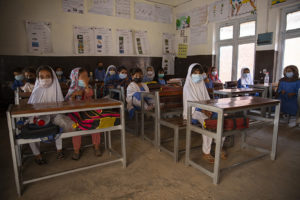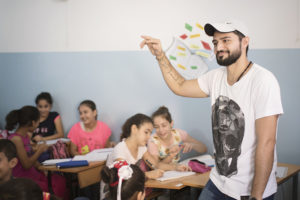Democratic Republic of Congo, Yemen, Syria, Uganda, South Sudan, Afghanistan, Ukraine… As of today, and according to data from Save the Children one in five children worldwide (approximately 420 million) live in war zones. The data show a devastating reality: also, according to Save the Children, five children are killed for every soldier killed in combat in today’s conflicts. And when images of conflict begin to flood our screens before they are forgotten, we see schools being bombed, people being separated from their families, recruited to become soldiers or subjected to sexual violence.
These children are not only deprived of their right to quality education and their chances for the future. The situation they are exposed to, where they are forced to leave their homes, their environments, their school and leave friends and family behind, is detrimental to their psychosocial development. How can we help them? How to ensure their access to quality education? How to respond to their needs for psychological and socio-emotional support? In this article we will explore some keys to help them cope with a situation that has left their lives and education up in the air.
Earmarking emergency funds for education
Education saves lives

Picture: ACNUR/Sayna Bashir
In the midst of conflict, education saves lives. “Schools can protect children from the traumas and physical dangers that surround them. When children are out of school, they are at greater risk of abuse, exploitation and recruitment into armed groups,” says Jo Bourne, UNICEF’s chief of education. For example, according to COALICO, in Colombia the interruption of classes during the COVID-19 pandemic increased the numbers of forced recruitment by armed groups by 113%. During episodes of instability and violence, schools must be able to be safe environments where children can not only learn, but also play and return to normalcy.
Education is the priority for children
According to a Save the Children report when children are asked what they need most in the midst of conflict, most say they want to continue their education. Because education does not only offer immediate, short-term protection in the midst of a crisis. We know that quality education is key for these children to reach their full potential and have a peaceful and prosperous future.
The “poor sister” of humanitarian aid
However, international agencies agree that education is always the ‘poor sister’ of humanitarian aid: the least funded sector in humanitarian appeals. According to the Inter-Agency Network for Education in Emergencies (INEE) in 2020, education received only 2.4% of total humanitarian aid; and UNICEF confirms that in Uganda, where refugees from the conflict in South Sudan are being cared for, the underfunding of education services is 89%.
Immediate psychosocial support

Armed conflict can greatly affect the healthy psychosocial development of children. Fear, anxiety, depression… to this must be added difficulties such as loss of months or even years of school as a consequence of displacement, new languages, lack of school materials, poor and insecure environments, problems of stigmatisation… Normally, national asylum procedures provide children with shelter, but their psychosocial needs are often not addressed. This can pose a major threat to their development and well-being. The good news is that, with the right support, most children are able to cope with all these adversities.
The organisation War Child has extensive experience in this type of intervention, backed up by numerous studies and research. Its programmes are designed for children and young people to develop their resilience and innate strengths, and are based on an integrated, multi-level approach that also addresses caregivers and teachers. What lessons can we learn from its experience?
Families and carers matter too
Children living in the midst of armed conflict do not grow up in isolation: the stress and physical threats they face often affect their parents and caregivers as well. This stress load can affect their ability to care for and protect children. Programmes should therefore be developed to reduce this stress and to strengthen their parenting skills. In addition to caregivers and parents, it is important to develop interventions that address the whole family, helping them to work together to develop positive interactions.
Caring for mental health in the community
Typically, in situations of armed conflict, resources for mental health care are largely non-existent and children are unable to receive the care they need. Simple, replicable and low-cost tools for early detection of such problems need to be developed. For example, War Child has developed an innovative and low-cost tool based on drawings showing images of children with socio-emotional problems. These illustrations enable trained community members to identify children with such problems and refer them to appropriate services. In this regard, the WHO has launched an intervention to enable children and adolescents to access treatment. The intervention (Early Adolescent Skills for Emotions) consists of seven group sessions for adolescents and three for their caregivers. The sessions are delivered by non-specialists but trained for this purpose (hence the ease of access, low cost and replicability) and are aimed, above all, at understanding emotions and stress management.
Play builds resilience
Play is a natural part of children’s activity from birth. It is a way of developing our cognitive abilities. As explained in this article from UNHCR play therapy is a method used in psychology to detect trauma in children who are not yet able to express it in words. But in older children, play also plays a key role in helping them to overcome their traumas. In addition to its educational value, it allows them to express themselves emotionally and, according to UNESCO, incorporates the concepts of friendship and respect for others. Fair play is defined as a way of thinking, not just a way of behaving.
Education for children in conflict situations cannot wait. In these particularly challenging and vulnerable contexts, technology and digital education can help overcome some of the barriers that children face every day. But how can we make the most of these technologies? How can they contribute to resolving these problems and obstacles? Stay tuned. We will see it in a future post.






